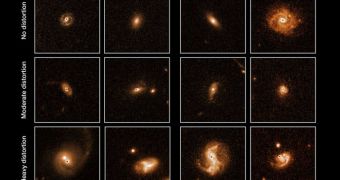Just when astronomers thought they had this one figured out, a new study comes along and contradicts all discoveries. Such was recently the case, when the conclusions of a new investigation showed that galaxy collisions may have not been the primary culprits behind the formation of large black holes.
For many years, experts believed that galactic collisions and mergers were responsible for the creation of supermassive black holes, the largest structures of this type in the entire Universe.
Astrophysicists were forced to look for a solution to this mystery, considering that regular phenomena could not explain how the structures grew to their tremendous size in the Universe's distant past.
For some of the largest structures of this type in the Cosmos, there simply wasn't enough material around them – cosmic dust or hydrogen gas – to allow for their amazing growth.
As such, experts proposed that collisions between galaxies were responsible for black hole growth spurt, given that the event caused a stirring of all the gas and dust in each galaxy, potentially bringing them closer together, and to the core of the resulting galaxy.
But the new research seems to suggest that other factors besides that were at work too. The study covered more than 140 galaxies with an active core, as well as some 1,200 galaxies that had relatively inactive cores, Space reports.
All of the galaxies in the survey were located within a distance of 8 billion light-years from Earth. The scientists in the new research were unable to find any direct, causal link between the number of galactic mergers and the growth of the black holes at the center of these galaxies.
“The implication is that the Universe is not evolving in such a violent way as previously thought, at least for the last 8 billion years,” explains the leader of the research team, Mauricio Cisternas.
The expert, who holds an appointment as an astronomer at the Max Planck Institute for Astronomy, in Heidelberg, Germany, adds that the Cosmos is now thought to have produced its first stars and galaxies less than a billion years after the Big Bang.
“You can usually tell when galaxies have been involved in a merger. Instead of the neat, geometric spiral or smooth elliptical shapes you usually see in Hubble images, colliding galaxies typically look distorted and warped,” says MPIA astronomer Knud Jahnke.
“We do not rule out that mergers actually might cause AGN activity in some cases. But they do not dominate the buildup of black hole mass over the last 8 billion years,” he adds.
According to the research team, the main culprits fueling black hole growth could include collisions of molecular clouds, instabilities within the galaxies themselves, or gravitational disruptions caused by other galaxies flying by.
“At these times there were more frequent mergers, by a factor of 10 or so, and the amount of gas in galaxies was much higher. Hence physics could be different and other mechanisms could be at work,” Jahnke adds.
The research team detailed its findings in a paper accepted for publication in the January 10 issue of the esteemed Astrophysical Journal.

 14 DAY TRIAL //
14 DAY TRIAL //